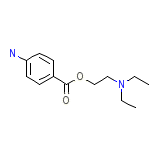Diethylaminoethyl P-Aminobenzoate




Categorie
Diethylaminoethyl P-Aminobenzoate Les marques, Diethylaminoethyl P-Aminobenzoate Analogs
- Allocaine
- Chloroprocaine Hcl
- Diethylaminoethyl P-Aminobenzoate
- Duracaine
- Duracillin A.S.
- Gerovital
- Gerovital H-3
- Jenacain
- Jenacaine
- Neocaine
- Nesacaine
- Nissocaine
- Norocaine
- Novocain
- Novocaine
- P-Aminobenzoyldiethylaminoethanol
- Penicillin G Procaine
- Pfizerpen-As
- Procain
- Procaine Hcl
- Procaine Hydrochloride
- Procaine, Base
- Scurocaine
- Spinocaine
- Vitamin H3
Diethylaminoethyl P-Aminobenzoate Les marques melange
Diethylaminoethyl P-Aminobenzoate Formule chimique
C13H20N2O2
Diethylaminoethyl P-Aminobenzoate RX lien
No information avaliable
Diethylaminoethyl P-Aminobenzoate FDA fiche
Diethylaminoethyl P-Aminobenzoate msds (fiche de securite des materiaux)
Diethylaminoethyl P-Aminobenzoate Synthese de reference
Aucune information disponible
Diethylaminoethyl P-Aminobenzoate Poids moleculaire
236.31 g/mol
Diethylaminoethyl P-Aminobenzoate Point de fusion
61 oC
Diethylaminoethyl P-Aminobenzoate H2O Solubilite
9450 mg / L
Diethylaminoethyl P-Aminobenzoate Etat
Solid
Diethylaminoethyl P-Aminobenzoate LogP
1.845
Diethylaminoethyl P-Aminobenzoate Formes pharmaceutiques
Liquid
Diethylaminoethyl P-Aminobenzoate Indication
Utilisé comme un anesthésique local essentiellement en chirurgie buccale
Diethylaminoethyl P-Aminobenzoate Pharmacologie
La procaïne est un agent anesthésique indiquée pour la production d'anesthésie locale ou régionale, en particulier pour la chirurgie orale. Procaïne (comme la cocaïne) a l'avantage de la constriction des vaisseaux sanguins qui réduit saignements, contrairement à d'autres anesthésiques locaux comme la lidocaïne. La procaïne est un anesthésique ester. Il est métabolisé dans le plasma par la pseudocholinestérase enzyme par hydrolyse en acide para-aminobenzoïque (PABA), qui est ensuite excrété par les reins dans l'urine.
Diethylaminoethyl P-Aminobenzoate Absorption
Aucune information disponible
Diethylaminoethyl P-Aminobenzoate Toxicite
Aucune information disponible
Diethylaminoethyl P-Aminobenzoate Information pour les patients
No information avaliable
Diethylaminoethyl P-Aminobenzoate Organismes affectes
Les humains et autres mammifères














